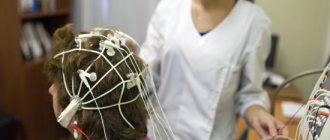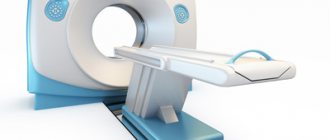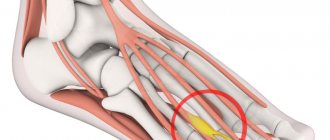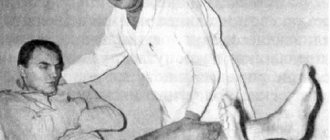The essence of the method and the possibilities of its application
Evoked potential is an electrical signal that nerve cells respond to an external stimulus or to perform a mental task.
In 1929, HansBerger from Germany drew attention to the bioelectrical activity of the brain: when an electrical impulse is transmitted from one neuron to another, weak electrical waves arise, and an electroencephalograph device can record them.
The electroencephalogram reflects the general bioelectrical activity of brain activity. It was impossible to isolate from it the reaction to external stimulation of any individual visual or auditory analyzer at that time, since the biofield of the evoked potential (from 0.5 to 15 μV) is tens and hundreds of times weaker than the general activity of the brain (20 - 50 μV).
Only in the middle of the twentieth century did a device appear that made it possible to isolate weak amplitudes of evoked potential oscillations from the total amplitude of brain activity. This occurs using the summation method: stimulation that stimulates the potential being studied is repeated from 100 to 1000 times at precise time intervals.
The computer summarizes only those segments of the encephalogram (EEG) that immediately follow the sensory stimulation. If the total amplitude during this time can increase and decrease, take on positive and negative values and in total tend to zero, then the evoked potential has the same response form and accumulates depending on the number of stimuli given.
The more stimulating external influences, the lower the “noise level” of the overall activity. An evoked potential with a high intrinsic amplitude is isolated quite cleanly with the help of 50–60 repetitions, and a weak response to a stimulus requires more than 500 repetitions for its isolation.
To use the evoked potential method, the following equipment is required:
- stimulus generator - a device made from electrodes on the head;
- bioelectric impulse amplifier
- analog-to-digital converter;
- computer for data processing;
- printer for printing.
Properties of evoked potentials
Necessary concepts for deciphering and interpreting the results:
- Latency is the time from the beginning of stimulation to the maximum value of the response impulse. Short-latency EPs (less than 0.050 sec); medium-latency (0.050 – 0.1 sec.); long-latency (longer than 0.1 sec.).
- Oscillation amplitude is the range of oscillation from maximum to minimum value.
- Polarity . To the same irritation, symmetrical parts of the brain can respond in diametrically opposite ways.
- Aftercharge is the decay time of the response pulse. It occurs 0.3 seconds after the stimulus is given and lasts from 0.5 seconds to 1 second).
Sensory evoked potentials are divided into visual, brainstem auditory, somatosensory, and motor. Studies of each of them make it possible to diagnose a variety of diseases of the nervous system.
Basic Basics:
Application of the VP method
Diagnosis of diseases is based on comparing the characteristics of evoked potentials of healthy people with data obtained in the study of patients with one or another disorder of the nervous system.
This is how they are diagnosed:
- multiple sclerosis;
- brain tumors;
- epilepsy;
- cerebral disorders;
- trigeminal nerve diseases;
- Parkinson's disease, etc.
Research is also carried out on the psychophysical activity of people, the characteristics of their behavior, the study and correlation of cognitive activity.
Contraindications
Pathological processes on the skin in this area are considered an absolute contraindication for the application of electrodes. Relative contraindications to this study are the presence of epilepsy, mental disorders, severe angina or hypertension, and a pacemaker in the patient. Complications can only arise if the study was used in the presence of relative contraindications. This could be an epileptic or mental attack, an attack of angina or a hypertensive crisis.
Reaction of the organs of vision
Visual evoked potentials are bioelectrical impulses from the brain in response to irritation of the visual organs. They examine vision all the way from the retina to the centers in the cerebral cortex located in the occipital part, and can determine the location and nature of its damage.
Visually evoked potentials (VEPs) use the visual analyzer to assess the functioning of the nervous system. They assume that the patient is able to focus his vision and keep his gaze at one point.
If the patient has an injury to the eye, optic nerve, or impaired thinking abilities, the VEP method is not recommended. In most cases, stimulation is given to one eye using LED glasses.
The study using the VEP method is carried out in two ways:
- Reaction to a flash of light . The study is carried out for patients who cannot fix their gaze or have difficulty seeing at all; The method is used for early diagnosis of visual impairment in newborns. Flashes are stimulated using a matrix in LED glasses; they are presented monocularly. The patient is in a room isolated from light and sound, his eyes are closed. Working electrodes are connected to the occipital region; reference electrodes are usually ear or frontal. To obtain a satisfactory picture of evoked potentials, it is sufficient to carry out from 50 to 100 stimulations. The response to an external stimulus will be a series of oscillations - positive and negative - with the same latency.
- Reaction to a change in chess pattern . The subjects observe a frequent change of cells - black and white. Large cells stimulate peripheral vision, small cells mobilize central vision. To isolate evoked potentials, it is necessary to make 100–200 external stimuli.
Interpretation of results
The following values are taken for analysis: N75; P10; N145. The index N means the lowest level (peak) of the pulse; P is the highest. The numbers 75, 100, 145 indicate the latency (duration) of each peak.
In all pathologies of the nervous system, the following is observed at these points:
- increased latency (due to impaired speed of impulses passing through the optic nerves;
- violation of symmetry, when readings from the right and left eyes differ (due to damage to the cerebral cortex);
- change in amplitude, both upward and downward. The P100 indicator is especially important for correct diagnosis.
VEPs are very important in the diagnosis of multiple sclerosis, epilepsy, concussions, diabetes mellitus, neuritis, visual impairment, etc.
The results of VEP analysis alone cannot provide a 100% diagnosis of the disease; it is necessary to use data from the clinical picture.
Methodology
No preparation required. On the day of the procedure, it is necessary to stop taking vascular drugs and tranquilizers, as they can distort the results of the examination. Flat electrodes lubricated with gel are applied to the patient’s head. They are connected to a device that records bioelectrical activity. When conducting a study using visual ERPs, the patient is asked to look at a TV screen that shows pictures (for example, a chessboard) or at flashes of bright light.
When conducting a study of auditory EPs, clicks and other sharp sounds are used. When studying somatosensory EPs, transcutaneous electrical stimulation of peripheral nerves is used. To study the function of the autonomic nervous system, electrical stimulation of the skin is performed. The device records changes in the bioelectrical activity of the cerebral cortex. Data on the conduction of nerve impulses arising after stimulation are processed on a computer.
Cost of evoked potentials in Moscow
The price of the study may fluctuate depending on several factors. The form of ownership of the medical and diagnostic institution has the greatest influence on the cost of the procedure. In private clinics, the price of evoked potentials in Moscow is usually higher than in public medical organizations. Differences in cost may also be due to different scope of the study (registration of visual, somatosensory, auditory, cutaneous and trigeminal potentials). In private medical centers, pricing is often based on the qualifications of the functional diagnostics doctor.
Brainstem evoked potentials to acoustic stimulation
Auditory evoked potentials are the response of the auditory nerve and parts of the brain (its stem part) to auditory stimuli.
The most common in medical practice are short-latency acoustic stimulation evoked potentials (ASEPs).
The sound signal along its path passes through 5 “stations” - departments of the central nervous system. Each of these centers responds to stimulation with an amplitude of bioelectric field oscillations with positive (P) and negative (N) peaks.
Amplitude bursts are produced by nerve centers in the following order: I. auditory nerve → II. cochlear nucleus →III. olive →IV. lateral lemniscus → V. inferior colliculus and cerebral cortex.
The signal transmission path of the auditory analyzer passes through the brain stem, which is associated with the vital functions of the body and its cognitive capabilities. Therefore, KASVP is used in assessing the condition of seriously ill patients in a coma, as well as in assessing a person’s intellectual activity.
The CASVP technique consists of using stimulation with short clicks, first on one ear, then on the other. Sound duration is 0.1 milliseconds, frequency is 10 clicks per second.
To record the evoked potential, the active electrode is placed on the crown, the control electrode is placed on the earlobe that receives the stimulus, and the ground electrode is placed on the opposite ear.
To accurately deduce CASVP from the general EEG background, the number of stimulating signals should be about 3000 with double averaging. The result is a graph of a wave function with five positive and negative peaks.
Interpretation of results
The absence of waves or the presence of only one amplitude instead of five indicates depression of vital centers and gives a poor prognosis for future life.
The following schedule changes are typical for a stroke:
- the interval between I, II and III peaks is increased;
- amplitude III became smaller;
- waves of II, IV, V centers have changed.
Multiple sclerosis and epilepsy give a picture of lengthening latent periods and changes in amplitudes.
Recent studies have established that component III of the evoked potential graph of the auditory analyzer - P300 (P is the designation of the positive peak, 300 is the latent period) is associated with cognitive evoked potentials.
A decrease in the amplitude of P300 and an extension of its latent period may indicate diseases of the intellectual sphere: schizophrenia, dementia, autism, parkinsonism, Alzheimer's disease.
Analysis of auditory evoked potentials is indispensable when searching for the causes of speech and hearing disorders in children, because make it possible to determine at what stage of sound signal transmission the failure occurs: either it is a peripheral disorder or a lesion of the central nervous system.
Evoked potentials of the auditory analyzer are included in the standard for examining infants for early diagnosis of developmental disorders.
conclusions
1. Changes in acoustic brain stem EPs are more specific than in other modalities. Using the study of ASVP, it is possible to identify damage to the peripheral part of the auditory analyzer, auditory nerve, stem structures, regardless of the age and degree of contact of the patient. In this case, the diagnostically significant criteria are the following: the absence of all or some peaks, an increase in their latencies, a decrease in amplitude, an interaural difference in latencies and/or amplitudes, doubling of peaks, distortion of their shape.
2. Changes in cortical auditory EPs are nosologically nonspecific. However, they make it possible to objectively assess the functional state of the central part of the auditory analyzer in various forms of central nervous system damage. Diagnostically significant criteria are the absence of a cortical peak, a decrease in its amplitude (> 2.5 sigma), an increase in latency (> 2.5 sigma), interhemispheric asymmetry of amplitudes/latencies, and distortion of the response form.












